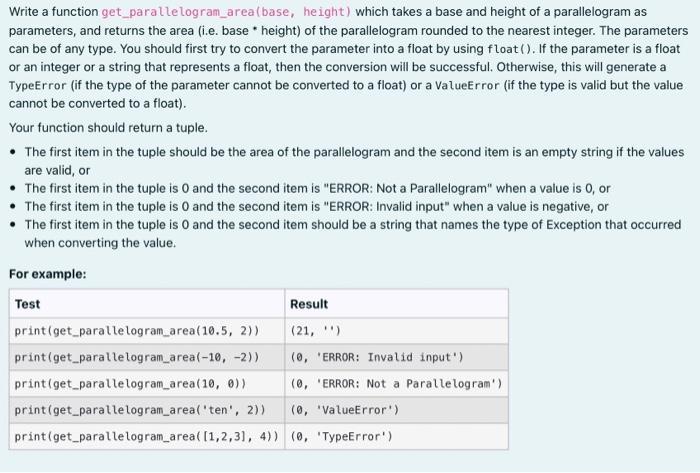Answered step by step
Verified Expert Solution
Question
1 Approved Answer
Write a function get_parallelogram_area (base, height) which takes a base and height of a parallelogram as parameters, and returns the area (i.e. base height)


Write a function get_parallelogram_area (base, height) which takes a base and height of a parallelogram as parameters, and returns the area (i.e. base height) of the parallelogram rounded to the nearest integer. The parameters can be of any type. You should first try to convert the parameter into a float by using float (). If the parameter is a float or an integer or a string that represents a float, then the conversion will be successful. Otherwise, this will generate a TypeError (if the type of the parameter cannot be converted to a float) or a ValueError (if the type is valid but the value cannot be converted to a float). Your function should return a tuple. The first item in the tuple should be the area of the parallelogram and the second item is an empty string if the values are valid, or The first item in the tuple is 0 and the second item is "ERROR: Not a Parallelogram" when a value is 0, or The first item in the tuple is O and the second item is "ERROR: Invalid input" when a value is negative, or The first item in the tuple is O and the second item should be a string that names the type of Exception that occurred when converting the value. For example: Test print (get_parallelogram_area(10.5, 2)) print(get_parallelogram_area(-10, -2)) print(get_parallelogram_area(10, 0)) Result (21, ) (0, 'ERROR: Invalid input') (0, 'ERROR: Not a Parallelogram') print (get_parallelogram_area('ten', 2)) (0, 'ValueError') print (get_parallelogram_area([1,2,3], 4)) (0, 'TypeError') Expected parallelogram_area(10.5, 2)) (21, ) parallelogram_area('10.5', -2)) (0, 'ERROR: Invalid input') barallelogram_area(-10, -2)) (0, 'ERROR: Invalid input') parallelogram_area(10, 0)) (0, 'ERROR: Not a Parallelogram') parallelogram_area('ten', 2)) (0, 'ValueError') barallelogram_area([1,2,3], 4)) (0, 'TypeError') Got (21, ) (0, 'ValueError') (0, 'ERROR: Invalid input') (0, 'ERROR: Not a Parallelogram") (0, 'ValueError') (0, 'TypeError') x
Step by Step Solution
★★★★★
3.44 Rating (160 Votes )
There are 3 Steps involved in it
Step: 1
The required code and test output are given below FUNCTION CODE def ge...
Get Instant Access to Expert-Tailored Solutions
See step-by-step solutions with expert insights and AI powered tools for academic success
Step: 2

Step: 3

Ace Your Homework with AI
Get the answers you need in no time with our AI-driven, step-by-step assistance
Get Started


